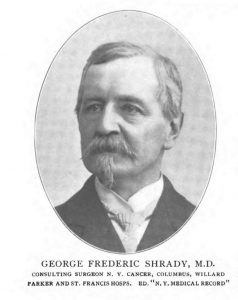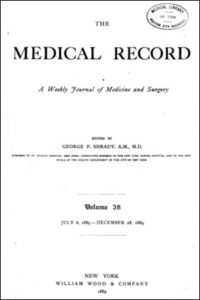We are pleased to present the first in a three-part series by E. Thomas Ewing, Professor of History and Associate Dean of the College of Liberal Arts and Sciences, and Sinclair Ewing-Nelson, a student of applied math and history of science and medicine at Yale University and Veronica Kimmerly, who graduated from Virginia Tech in 2014, with degrees in math, German, and engineering, and is now studying in a graduate program at Edinburgh University in Scotland. You can find out more about the Russian flu project in the other parts of this series and at the project’s website!
Part One: Anticipating an Epidemic
In early January 1890, an especially widespread outbreak of influenza that had quickly spread across Europe now seemed likely to reach the United States. Responding to this perceived danger, the Medical Record, a weekly journal, published an editorial on January 4, 1890, by Dr. George F. Shrady, which proclaimed with great certainty that a disease “of such a mild type” did not pose any serious danger to the American people. After describing common symptoms and recommended treatments for a disease popularly known as “the grip,” Shrady reassured the public that “the epidemic of influenza” was neither unusual nor dangerous. This editorial quickly reached a much broader audience when newspapers across the United States republished most or all of the text or referenced the journal’s authoritative statements about the disease. By examining the dissemination of information along with the spread of disease, this case study explores the complex relationship between medical expertise and public sentiments during a public health crisis.

1: Portrait of Dr. George F. Shrady (Source: Notable New Yorkers of 1896-1899 (New York: Moses King, 1899), p. 346.
This three part posting examines distinctive stages in the way that a single journal, the Medical Record, and its editor, Dr. Shrady, shaped public discourse about a disease epidemic. In late nineteenth century America, medical authority derived from multiple sources, including having acquired credentials as a doctor, assuming a faculty position in a medical school, serving as the editor of a medical journal, and participating on a municipal or state board of health. When a disease outbreak started, individuals in these positions issued statements about issues such as symptoms, prevention, treatment, and likely outcomes. Prior to the establishment of the Centers for Disease Control and Prevention, the Office of the Surgeon General, and the National Institutes of Health—the federal agencies which now coordinate responses to disease outbreaks—a single doctor could make authoritative statements that shaped both expert and popular perceptions during a public health crisis.
This case study focuses on a key moment in a disease outbreak, when the public first became aware of the scope of an epidemic and when authorities seek to intervene in ways that shape public perceptions about the likely impact of the disease (Ewing, et al, 2016). In recent years, for example, the United States has reached this moment during the H1N1 influenza epidemic in early 2009, Middle East Respiratory Syndrome (MERS) in 2012, the Ebola outbreak in summer 2014, and most recently with the Zika virus in early 2016. As was the case with the so-called “Russian influenza,” which acquired its name after especially numerous cases were identified in the capital city, St. Petersburg, in October 1889, these more recent diseases first attracted the attention of the American public when their effects were becoming widespread in other regions of the world, thus raising the obvious question of whether the disease would reach the United States. By exploring the ways that a single medical authority, Dr. Shrady, addressed similar issues in 1890, and the ways that his recommendations were disseminated, endorsed, challenged, and ultimately exploited for commercial purposes, this case study provides a method for thinking critically about public responses to disease outbreaks in the future.
Born in New York City in 1837, Dr. George F. Shrady (Illustration 1) was educated at the College of the City of New York and completed medical training at the College of Physicians and Surgeons in 1858; he later received an honorary Master of Arts degree from Yale. After service in the U.S. military during the Civil War, Shrady returned to New York City to assume a leading position as an innovative surgeon, consulting physician, and medical editor. In 1866, Shrady became the founding editor of Medical Record, a leading weekly medical periodical published in New York City, which he continued to edit until 1904. A leading figure in medical associations in the city and at the national level for nearly four decades, Shrady died in 1907, at the age of seventy years.

2: Medical Record, Title Page for Vol. 37
The Medical Record was one of several medical journals that circulated widely in print form and were often cited in newspaper reports about health issues (Illustration 2). Medical journals are an especially valuable and accessible source for students interested in studying the history of disease. On December 7, 1889, the Medical Record published a brief summary of widespread incidents of disease in Russia (Illustration 3). In the subsequent issue, December 14, 1889, an editorial by Dr. Shrady predicted that the influenza would reach the United States, but “the disease is not dangerous” and “but slightly if at all contagious.” A brief notice published on December 21, 1889 questioned the remedy for influenza prescribed by the New York Board of Health, and encouraged “an explanation and an apology” to the medical profession and to the public. In the final issue for the year, December 28, 1889, the Medical Record published a first-hand report about the influenza in St. Petersburg, reprinted from the British Medical Journal, which included detailed accounts of individual cases observed by a physician.
The Medical Heritage Library, a digital consortium of the major medical historical libraries, allows for catalog searches of titles, authors, and subjects as well as key word searching of entire texts. Researchers should also use the index included with most published volumes to identify specific articles, authors, and subjects.

3: Medical Record, Masthead, December 7, 1889
In the case of the Medical Record, for example, the indices for Volumes 36 and 37, which cover the period from July 1889 to June 1890, list nearly forty articles under the heading “influenza.” By making medical journals widely available to public users, the Medical Heritage Library offers scholars, students, and general audiences a remarkable opportunity to trace the impact of key texts in shaping both expert and public understanding of a public health crisis. In the case of the Russian flu, reviewing the first articles published by the Medical Record in December 1889 shows a growing anticipation of the coming of the disease, as well as cautious optimism about its likely limited impact on American health. These articles also reveal the emerging network of communications among medical journals, as they reprinted articles from other publications, thus furthering the impact of each journal. The Medical Heritage Library is an especially valuable resource for exploring the latter theme, as researchers can compare content of journals, trace articles from one source to another, and explore the power of networked knowledge emerging in these journals.





